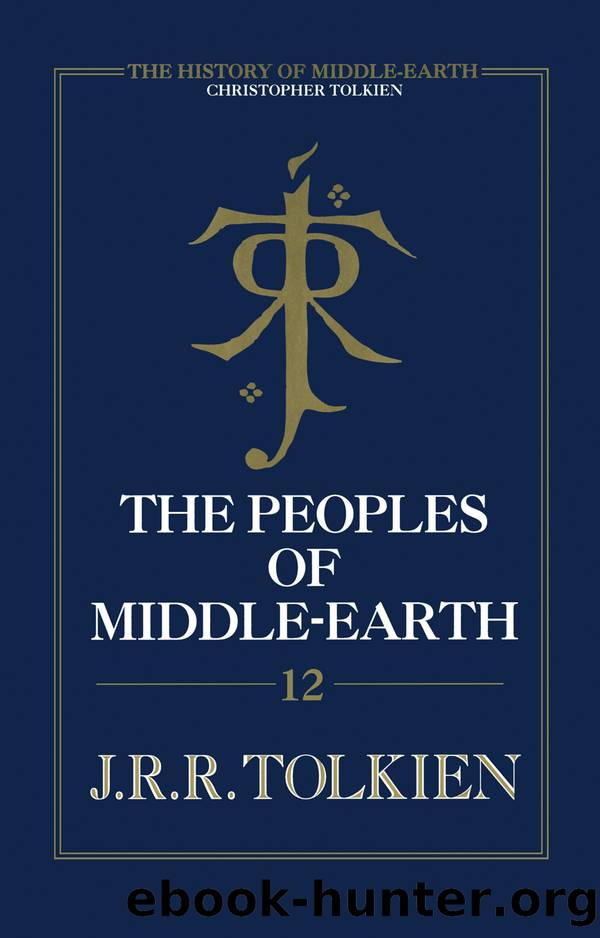The Peoples of Middle-earth (The History of Middle-earth, Book 12) by J. R. R. Tolkien and Christopher Tolkien

Author:J. R. R. Tolkien and Christopher Tolkien
Language: eng
Format: epub
Publisher: HarperCollinsPublishers
Published: 2019-07-13T00:00:00+00:00
IX
THE MAKING OF APPENDIX A
(I) THE REALMS IN EXILE
As with the major manuscript T 4 of the Tale of Years given in the last chapter, I believe that years passed after the making of the manuscript C of The Heirs of Elendil (pp. 191 ff.) before my father took up the matter again, with a view to its radical alteration, when The Lord of the Rings was assured of publication. His later work on this, almost entirely in typescript, is extremely difficult to explain.
The earliest text, which I will call I, of the later period is a very rough typescript which begins thus:
The Heirs of Elendil
There is no space here to set out the lines of the kings and lords of Arnor and Gondor, even in such brief form as they appear in the Red Book. For the compiling of these annals the Hobbits must have drawn both on the books of lore in Rivendell, and on records made available to them by King Elessar, such as the âBook of the Kingsâ of Gondor, and the âHouse of the Stewardsâ; for until the days of the War of the Ring they had known little of such matters, and afterwards were chiefly interested in them in so far as they concerned Elessar, or helped in the correction of the dating of their own annals.
The line of Arnor, the Heirs of Isildur. After Elendil and Isildur there were eight high kings in Arnor, ending with Eärendur. The realm of Arnor then became divided, and the kings ceased to take names in High-elven form. But the line was maintained by Amlaith son of Eärendur, who ruled at Fornost.
After Amlaith there were thirteen kings1 at Fornost, of whom the last was Arvedui, the twenty-fifth of the line. When he was lost at sea, the kingship came to an end in the North, and Fornost was deserted; but the line was continued by the Lords of the Dúnedain, who were fostered by Elrond.
Of these the first was Aranarth son of Arvedui, and after him there followed fifteen chieftains, ending with Aragorn II, who became king again both of Arnor and Gondor.
It was the token and the marvel of the Northern line that, though their power departed and their people dwindled to few, through all the many generations the succession was unbroken from father to son. Also, though the length of the lives of the Dúnedain grew ever less in Middle-earth, and their waning was swifter in the North, while the kings lasted in Gondor, afterwards it was otherwise; and many of the chieftains of the North lived still to twice the age of the oldest of other Men. Aragorn indeed lived to be one hundred and ninety years of age, longer than any of his line since Arvegil son of King Argeleb II; but in Aragorn the dignity of the kings of old was renewed, and he received in some measure their former gifts.
In his opening words âThere is no space here to set out
Download
This site does not store any files on its server. We only index and link to content provided by other sites. Please contact the content providers to delete copyright contents if any and email us, we'll remove relevant links or contents immediately.
Evelina by Fanny Burney(26769)
Evelina, Or, the History of a Young Lady's Entrance into the World by Fanny Burney(26213)
Twilight of the Idols With the Antichrist and Ecce Homo by Friedrich Nietzsche(18473)
Pale Blue Dot by Carl Sagan(4883)
The Perks of Being a Wallflower by Stephen Chbosky(4548)
Dune 01 Dune by Frank Herbert(4284)
Double Down (Diary of a Wimpy Kid Book 11) by Jeff Kinney(4174)
Man and His Symbols by Carl Gustav Jung(4053)
Walking by Henry David Thoreau(3875)
Separate Beds by LaVyrle Spencer(3754)
Ficciones by Jorge Luis Borges(3550)
FOUNDATION AND EMPIRE by Isaac Asimov(3531)
The 101 Dalmatians by Dodie Smith(3438)
Mystery at School by Laura Lee Hope(3348)
Anna and the French Kiss by Stephanie Perkins(3303)
120 Days of Sodom by Marquis de Sade(3159)
Some Prefer Nettles by Tanizaki Junichiro(2825)
The Little Prince by Antoine de Saint-Exupéry(2813)
My Ántonia by Willa Cather(2723)
